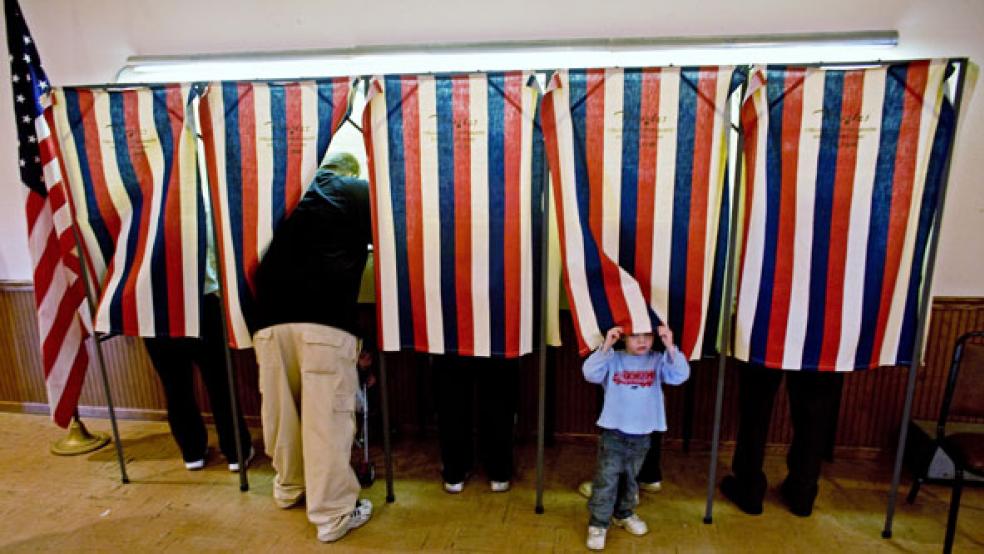The best thing about elections — if you are a numbers nerd like me — is the massive amount of raw data about the American public and what they think, as well as the how and why of it.
Yes, only about 36 percent of eligible voters cast ballots three weeks ago, but that amounts to almost 77 million people — a pretty great sample to sort through.
I sifted through the national exit poll in search of clues about the state of the American electorate.
The nine numbers that jumped out at me are below.
■ 4. That’s the margin by which Democrats beat Republicans among women nationwide in the vote for the House. That’s a significant decline from President Obama’s winning margins among women (11 in 2012, 13 in 2008), though it’s an improvement from the 2010 midterms, when Democrats lost the women’s vote by a point. Still, the massive focus of Democratic candidates across the country on the Republican Party’s supposed “war on women” clearly didn’t persuade large numbers of female voters to abandon the GOP. Assuming Hillary Clinton is the Democratic presidential nominee in 2016, the historic nature of her candidacy as the first female may erase any doubts about a shrinking gender-gap edge for Democrats. But, in midterm elections at least, women are simply not an overwhelmingly Democratic constituency.
Related: The New Senate Power Grid: Here's Who Has the Juice
■ 62. That’s the percentage of the vote for Democrats among those who said they “never” attend any sort of religious services; Republicans won just 36 percent among that group. Compare that with the 18-point edge Republicans enjoyed over Democrats among those who go to some sort of religious service weekly and you see that one’s religiosity continues to be among the most reliable predictors of how they will vote. Consider yourself a religious person, or, at least, someone who attends religious services regularly? There’s a strong likelihood you are voting Republican. Not a churchgoer? You are voting Democratic.
■ 54. A majority of Americans who went to the polls Nov. 4 believe that the “government is doing too many things better left to businesses and individuals,” while just 41 percent think “the government should do more to solve problems.” Those numbers suggest that the long-running battle over what government can and should do (and how much it should do) is tilting back toward the smaller-is-better crowd that dominated in the mid- and late 1990s. The early years of Obama’s presidency were defined by a belief that government might need to do more than it had during the latter days of the George W. Bush administration. (Think Hurricane Katrina.) But the pendulum is in the process of swinging back to the government-shrinkage folks.
Related: How the Media Helped the GOP Walk Away with the Midterms
■ 79. How people feel about their government is this number, which represents the percentage of people who say you can only “sometimes” (60 percent) or “never” (18 percent) trust Washington “to do what is right.” That’s stunning. The number is partly attributable to a Republican-flavored electorate and the natural suspicion among many within the GOP of the federal government — particularly when it’s run by a Democratic president. But the number is so high that it’s hard not to see the problems surrounding the Internal Revenue Service, Veterans Affairs and, of course, the National Security Agency’s spying revelations as part of that deepening distrust among broad swaths of the American public.
■ 48. That’s the percentage of people who said same-sex marriage should be legal in their state, the same number that said it should be illegal. That even split is a significant break from most polling on the issue; Gallup’s most recent poll, in May, on same-sex marriage showed 55 percent of Americans supporting it while 42 percent opposed it. What explains the discrepancy? Maybe the difference between asking whether same-sex marriage should be legal in your state versus asking, more broadly, about its legality. Or maybe that people are less willing to tell someone over the phone what they really feel about a divisive social issue than in person. (That seems odd.) Maybe the difference between “legal” (the exit poll language) and “valid” (Gallup’s language). Or that this midterm electorate was a Republican-friendly one.
Related: Election 2014: The Most Expensive Midterms Ever
■ 75. Three-quarters of the 2014 electorate was white (and they voted for Republicans by 22 points) on Nov. 4. That might seem like great news for Republicans. It’s not. Whites made up 77 percent of the 2010 electorate — and the decline in whites as a percentage of the overall electorate is happening in presidential cycles, too.
■ 38. The percentage of the white vote that Democratic candidates won nationwide. That’s the same percentage Democrats got among white voters in the 2010 midterms and virtually equal to the 39 percent Obama won in the 2012 election. That’s a trend — and a downward one for Democrats. From 1996 to 2008, the Democratic presidential nominee always won 41 to 43 percent of the white vote.
Related: Hillary's 3 Million Ground Forces Are Armed and Ready for 2016
■ 36. That’s the percentage of the Hispanic vote that Republicans won Nov. 4, an improvement on the 34 percent they won in 2010 and a major step up from the 27 percent that Mitt Romney took in 2012. It was the strongest showing for Republicans among Hispanic voters since Bush won 44 percent of the Latino vote in the 2004 election. (Bush’s showing was, by far, the best performance for a Republican presidential nominee since 1972.) It remains to be seen how Obama’s executive action on immigration — and the Republican response to it — will affect those numbers in the long run, but 2014 was a step in the right direction for Republicans among Latinos.
■ 53. A majority of voters who identified as “moderates” (four in every 10 voters) cast ballots for Democrats. Republicans got 45 percent of the moderate vote. That’s a good reminder that a) “moderate” does not equal “independent” (Republicans won “independents” by 12 points) and b) this election was not decided by “the middle.” It was decided by the Republican base or, put another way, the no-show of the Democratic base.
This article originally appeared in The Washington Post.
Read more at The Washington Post:
Pessimism grows on eve of Iran nuclear deadline
At least 45 Afghan deaths blamed on suicide bomber
Boy with fake gun in Ohio dies after officer shooting





